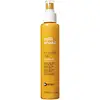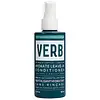What's inside
What's inside
 Key Ingredients
Key Ingredients

 Benefits
Benefits

 Concerns
Concerns

 Ingredients Side-by-side
Ingredients Side-by-side

Water
Skin ConditioningCetearyl Alcohol
EmollientPropylene Glycol
HumectantPhenyl Trimethicone
Skin ConditioningCyclopentasiloxane
EmollientBehentrimonium Chloride
PreservativeQuaternium-80
Cyclohexasiloxane
EmollientAstrocaryum Murumuru Seed Butter
EmollientVaccinium Myrtillus Fruit Extract
Skin ConditioningMangifera Indica Fruit Extract
Skin ConditioningCarica Papaya Fruit Extract
Skin ConditioningRubus Idaeus Fruit Extract
AstringentEthylhexyl Methoxycinnamate
UV AbsorberBenzyl Alcohol
PerfumingGlyceryl Caprylate
EmollientGlyceryl Undecylenate
EmollientPEG-5 Cocomonium Methosulfate
Sodium Glutamate
MaskingHydrolyzed Milk Protein
Skin ConditioningHydroxypropyltrimonium Hydrolyzed Casein
Skin ConditioningSodium Cocoyl Glutamate
CleansingHydroxypropyl Guar Hydroxypropyltrimonium Chloride
Tocopherol
AntioxidantLactic Acid
BufferingParfum
MaskingWater, Cetearyl Alcohol, Propylene Glycol, Phenyl Trimethicone, Cyclopentasiloxane, Behentrimonium Chloride, Quaternium-80, Cyclohexasiloxane, Astrocaryum Murumuru Seed Butter, Vaccinium Myrtillus Fruit Extract, Mangifera Indica Fruit Extract, Carica Papaya Fruit Extract, Rubus Idaeus Fruit Extract, Ethylhexyl Methoxycinnamate, Benzyl Alcohol, Glyceryl Caprylate, Glyceryl Undecylenate, PEG-5 Cocomonium Methosulfate, Sodium Glutamate, Hydrolyzed Milk Protein, Hydroxypropyltrimonium Hydrolyzed Casein, Sodium Cocoyl Glutamate, Hydroxypropyl Guar Hydroxypropyltrimonium Chloride, Tocopherol, Lactic Acid, Parfum
Water
Skin ConditioningCetearyl Alcohol
EmollientCitrus Aurantium Dulcis Fruit Extract
MaskingCitrus Limon Fruit Extract
MaskingPyrus Malus Fruit Extract
Skin ConditioningSaccharum Officinarum Extract
MoisturisingBambusa Vulgaris Extract
Skin ConditioningCamellia Sinensis Leaf Extract
AntimicrobialArgania Spinosa Kernel Oil
EmollientOrbignya Oleifera Seed Oil
EmollientMoringa Oleifera Seed Oil
EmollientHydrolyzed Quinoa
Skin ConditioningCeramide Ng
Skin ConditioningAnhydroxylitol
HumectantHydrolyzed Vegetable Protein Pg-Propyl Silanetriol
Skin ConditioningGlycerin
HumectantEthylhexylglycerin
Skin ConditioningCitric Acid
BufferingSaccharide Isomerate
HumectantPolyglyceryl-10 Caprylate
EmulsifyingXylityl Sesquicaprylate
AntimicrobialSorbitan Oleate Decylglucoside Crosspolymer
CleansingPolyacrylate-1 Crosspolymer
Silicone Quaternium-16
Skin ConditioningPanthenol
Skin ConditioningParfum
MaskingQuaternium-91
Cetrimonium Methosulfate
AntimicrobialPhenyl Trimethicone
Skin ConditioningButyloctanol
HumectantAcetic Acid
BufferingUndeceth-5
EmulsifyingUndeceth-11
EmollientBenzalkonium Chloride
AntimicrobialSodium Chloride
MaskingSodium Citrate
BufferingDisodium EDTA
Methyl Palmitate
EmollientIodopropynyl Butylcarbamate
PreservativeBenzyl Alcohol
PerfumingPotassium Sorbate
PreservativePhenoxyethanol
PreservativeSodium Benzoate
MaskingBenzyl Salicylate
PerfumingWater, Cetearyl Alcohol, Citrus Aurantium Dulcis Fruit Extract, Citrus Limon Fruit Extract, Pyrus Malus Fruit Extract, Saccharum Officinarum Extract, Bambusa Vulgaris Extract, Camellia Sinensis Leaf Extract, Argania Spinosa Kernel Oil, Orbignya Oleifera Seed Oil, Moringa Oleifera Seed Oil, Hydrolyzed Quinoa, Ceramide Ng, Anhydroxylitol, Hydrolyzed Vegetable Protein Pg-Propyl Silanetriol, Glycerin, Ethylhexylglycerin, Citric Acid, Saccharide Isomerate, Polyglyceryl-10 Caprylate, Xylityl Sesquicaprylate, Sorbitan Oleate Decylglucoside Crosspolymer, Polyacrylate-1 Crosspolymer, Silicone Quaternium-16, Panthenol, Parfum, Quaternium-91, Cetrimonium Methosulfate, Phenyl Trimethicone, Butyloctanol, Acetic Acid, Undeceth-5, Undeceth-11, Benzalkonium Chloride, Sodium Chloride, Sodium Citrate, Disodium EDTA, Methyl Palmitate, Iodopropynyl Butylcarbamate, Benzyl Alcohol, Potassium Sorbate, Phenoxyethanol, Sodium Benzoate, Benzyl Salicylate
 Reviews
Reviews

Ingredients Explained
These ingredients are found in both products.
Ingredients higher up in an ingredient list are typically present in a larger amount.
Benzyl Alcohol is most commonly used as a preservative. It also has a subtle, sweet smell. Small amounts of Benzyl Alcohol is not irritating and safe to use in skincare products. Most Benzyl Alcohol is derived from fruits such as apricots.
Benzyl Alcohol has both antibacterial and antioxidant properties. These properties help lengthen the shelf life of products. Benzyl Alcohol is a solvent and helps dissolve other ingredients. It can also improve the texture and spreadability.
Alcohol comes in many different forms. Different types of alcohol will have different effects on skin. This ingredient is an astringent alcohol.
Using high concentrations of these alcohols are drying on the skin. They may strip away your skin's natural oils and even damage your skin barrier. Astringent alcohols may also irritate skin.
Other types of astringent alcohols include:
According to the National Rosacea Society based in the US, you should be mindful of products with these alcohols in the top half of ingredients.
Any type of sanitizing product will have high amounts of alcohol to help kill bacteria and viruses.
Learn more about Benzyl AlcoholCetearyl alcohol is a mixture of two fatty alcohols: cetyl alcohol and stearyl alcohol. It is mainly used as an emulsifier. Emulsifiers help prevent the separation of oils and products. Due to its composition, it can also be used to thicken a product or help create foam.
Cetearyl alcohol is an emollient. Emollients help soothe and hydrate the skin by trapping moisture.
Studies show Cetearyl alcohol is non-toxic and non-irritating. The FDA allows products labeled "alcohol-free" to have fatty alcohols.
This ingredient is usually derived from plant oils such as palm, vegetable, or coconut oils. There is debate on whether this ingredient will cause acne.
Due to the fatty acid base, this ingredient may not be Malassezia folliculitis safe.
Learn more about Cetearyl AlcoholParfum is a catch-all term for an ingredient or more that is used to give a scent to products.
Also called "fragrance", this ingredient can be a blend of hundreds of chemicals or plant oils. This means every product with "fragrance" or "parfum" in the ingredients list is a different mixture.
For instance, Habanolide is a proprietary trade name for a specific aroma chemical. When used as a fragrance ingredient in cosmetics, most aroma chemicals fall under the broad labeling category of “FRAGRANCE” or “PARFUM” according to EU and US regulations.
The term 'parfum' or 'fragrance' is not regulated in many countries. In many cases, it is up to the brand to define this term.
For instance, many brands choose to label themselves as "fragrance-free" because they are not using synthetic fragrances. However, their products may still contain ingredients such as essential oils that are considered a fragrance by INCI standards.
One example is Calendula flower extract. Calendula is an essential oil that still imparts a scent or 'fragrance'.
Depending on the blend, the ingredients in the mixture can cause allergies and sensitivities on the skin. Some ingredients that are known EU allergens include linalool and citronellol.
Parfum can also be used to mask or cover an unpleasant scent.
The bottom line is: not all fragrances/parfum/ingredients are created equally. If you are worried about fragrances, we recommend taking a closer look at an ingredient. And of course, we always recommend speaking with a professional.
Learn more about ParfumPhenyl Trimethicone is a silicon-based polymer. It is derived from silica.
Phenyl Trimethicone is used as an emollient and prevents products from foaming.
As an emollient, it helps trap moisture in the skin. It is considered an occlusive.
Learn more about Phenyl TrimethiconeWater. It's the most common cosmetic ingredient of all. You'll usually see it at the top of ingredient lists, meaning that it makes up the largest part of the product.
So why is it so popular? Water most often acts as a solvent - this means that it helps dissolve other ingredients into the formulation.
You'll also recognize water as that liquid we all need to stay alive. If you see this, drink a glass of water. Stay hydrated!
Learn more about Water